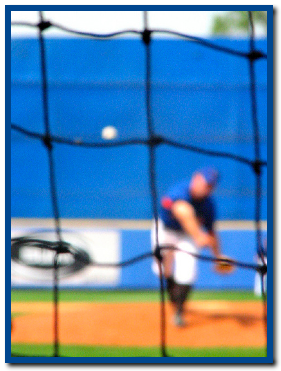The Situation of the “Curveball”
Posted by The Situationist Staff on November 1, 2009
 From U.S. News:
From U.S. News:
“Physically, there is no such thing as a breaking curveball,” said Zhong-Lin Lu, who holds the William M. Keck Chair in Cognitive Neuroscience at the University of Southern California, in Los Angeles. “It’s mostly in the hitter’s mind.”
According to Lu, who helped to design a popular Web animation that illustrates the science behind what he calls the curveball illusion, the ball travels relatively straight toward the batter, curving somewhat but not nearly as much as claimed. What causes the perception of the break is a complex interplay between the fast spin of the ball, the contrast between the ball’s red seams and white background, and the batter’s flawed visual perception as the ball nears the plate.
Here’s how the curveball phenomenon seems to work, said Lu, a visual motion and perception specialist:
The ball leaves the pitcher’s arm at approximately 75 mph, slower than an average fastball. While it hurtles toward the batter, the ball spins obliquely at around 1,500 rpm (or 25 rotations per second). The ball reaches the plate in about 0.6 seconds.
Because of its unique spin, the ball appears to be moving faster than it really is, causing the batter to overestimate the speed. A slight curving trajectory forces the ball to move somewhat away from the hitter’s frontal view toward his side — or peripheral — vision just before he swings.
It’s during this final shifting of perception from frontal (also known as foveal) to peripheral view that causes the batter to perceive that the ball is dramatically dropping or moving abruptly to the left or right. In fact, the curveball is moving relatively straight, Lu said.
“The greater your eyes move away from the ball, the greater the curve,” he said.
* * *
From EurekaAlert:
Zhong-Lin Lu, a professor of cognitive neuroscience at USC, along with USC alumni Emily Knight and Robert Ennis and Arthur Shapiro, associate professor of psychology at American University, developed a simple visual demo that suggests a curveball’s break is, at least in part, a trick of the eye.
Their demo, viewable at outstanding Illusion Sciences blog (here), won the Best Visual Illusion of the Year prize at the Vision Sciences meeting earlier this year.
* * *
To read a sample of related Situationist posts, see “Jim Rice and the Situation of Baseball Hall of Fame Voting,” “Big Papi Magic,” “The Situation of a Baseball Pitch,” “The Batting Situation,” and “The Unconscious Genius of Baseball Players.” To review other Situationist posts containing of discussing illusions, click here. Finally, to review a collection of similarly fascinating illusions by Arthur Shapiro, go to Illusion Sciences Blog.


















ulyssesmsu said
What’s *really* a trick of the mind is this “explanation” of how a curveball “doesn’t really curve.” Hasn’t Mr. Lu ever heard of Bernoulli? It’s incredible how every so often some scientist trots out another explanation of supposedly why a curveball is an illusion. But anyone who has ever played or umpired baseball knows that any such explanation is just pure nonsense.
Tim C said
My dad was an MLB-scouted catcher in high school, also a good hitter (back injury derailed his baseball career) but he knows a lot about baseball from a technique angle, so I asked him about this post. His response:
This guy doesn’t know what he’s talking about.
When a pitcher’s curve ball isn’t “working” – it isn’t because the batter’s perception is dealing with reality better – it is because the ball isn’t breaking near as much. He obviously hasn’t been a pitcher or a catcher – no does he explain the actual visible reality of watching a slow motion replay in which the ball is coming toward the catcher’s mit – which is 3 feet off the ground, and suddenly, the ball drops and at times even hits the plate.
An example of this was in the WS game – it was Werth for the Phillies – they show how he struck out the first time up on a huge breaking curve ball. His next time up, the pitcher threw the same pitch with 2 strikes, and he got a base hit – but the ball didn’t drop near as much.